
Banksia calophylla is a species of shrub that is endemic to Western Australia. It has a fire-tolerant, underground stem, pinnatifid leaves that have woolly hairs on the lower surface and heads of thirty to forty-five yellowish brown flowers surrounded by hairy bracts.

Olearia axillaris, commonly known as coastal daisy-bush, coast daisy-bush or coastal daisybush is a species of flowering plant in the family Asteraceae and is endemic to coastal areas of Australia. It is an erect, bushy shrub with densely cottony-hairy branchlets, aromatic, linear to narrowly elliptic or narrowly lance-shaped to egg-shaped leaves with the narrower end towards the base and small white and yellow, daisy-like inflorescences.

Olearia mooneyi, commonly known as pumpkin bush, is a species of flowering plant in the family Asteraceae and is endemic to Lord Howe Island. It is a shrub or small tree with hairy, elliptic to egg-shaped leaves with the narrower end towards the base, and white and pale yellow, daisy-like inflorescences.
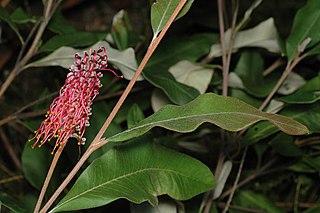
Grevillea macleayana, commonly known as Jervis Bay grevillea, is a species of flowering plant in the family Proteaceae and is endemic to south-eastern New South Wales. It is a spreading shrub with egg-shaped to elliptic, sometimes lobed leaves, and greenish or greyish flowers with a pink to red style.

Grevillea fistulosa, commonly known as Barrens grevillea or Mount Barren Grevillea, is a species of flowering plant in the family Proteaceae and is endemic to the Fitzgerald River National Park in the south-west of Western Australia. It is an erect shrub with narrowly egg-shaped to broadly linear leaves and clusters of orange-red to scarlet flowers.

Quoya dilatata is a flowering plant in the mint family Lamiaceae and is endemic to Western Australia. It is a low, spreading shrub with its branches and leaves densely covered with a layer of white, woolly hairs. The leaves are wrinkled or crinkly and the tube-shaped flowers are orange-red and hairy on the outside.

Olearia iodochroa, commonly known as the violet daisy bush, is a species of flowering plant in the family Asteraceae and is endemic to south-eastern continental Australia. It is a shrub with branchlets densely covered with whitish hairs, narrowly egg-shaped leaves with the narrower end towards the base, and white or mauve, and cream-coloured, yellow or blue, daisy-like inflorescences.
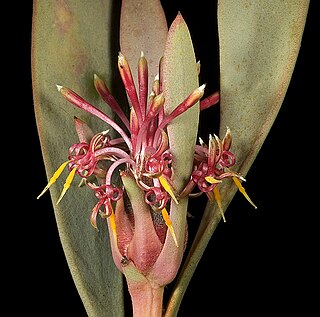
Isopogon pruinosus is a species of flowering plant in the family Proteaceae and is endemic to southwestern Western Australia. It is a compact, spreading shrub with narrow egg-shaped leaves with the narrower end towards the base and spherical to elliptic heads of pink flowers.

Felicia nordenstamii is a flowering shrub in the family Asteraceae. It is found only in South Africa where it grows on limestone hills close to the sea on the southern coast. Felicia nordenstamii is a many-branched shrub growing up to 30 cm (1 ft) tall. The lower parts of the stems are covered in grayish brown bark and the upper stem has many crowded, upwardly angled, alternate leaves with long hairs on the lower surfaces. Large flower heads form at the tips of the branches, each about 41⁄2 cm across, with about thirty purplish blue ray florets surrounding many yellow disc florets.

Mairia burchellii is a tufted perennial plant of up to 15 cm (6 in) assigned to the family Asteraceae. It has narrow leaves of up to 5 mm (0.20 in) wide, with single main vein and an entire margin. Flower heads only occur after a fire has destroyed the standing vegetation, mostly in November or between February and June. The flower heads sit individually or with a few on the tip of a purplish stalk, with a few narrow bracts, and consist of a row of pinkish ray florets around many yellow disc florets. It can be found in the southwest of the Western Cape province of South Africa.

Pomaderris queenslandica, commonly known as scant pomaderris, is a species of flowering plant in the family Rhamnaceae and is endemic to eastern Australia. It is a shrub with woolly-hairy stems, egg-shaped to narrowly elliptic leaves, and panicles of creamy-yellow flowers.
Lasiopetalum angustifolium, commonly known as narrow leaved lasiopetalum, is a species of flowering plant in the family Malvaceae and is endemic to coastal areas of south-western Western Australia. It is a low spreading or dense, compact shrub with narrowly egg-shaped to narrowly elliptic leaves and compact groups of pink to purplish flowers.
Lasiopetalum compactum, is a species of flowering plant in the family Malvaceae and is endemic to the south-west of Western Australia. It is an erect shrub with leathery, narrowly oblong leaves and cymes of white to pinkish flowers.

Olearia brachyphylla is a species of flowering plant in the family Asteraceae and is endemic to southern continental Australia. It is a densely-branched, aromatic shrub with woolly-hairy stems, oblong to egg-shaped leaves with the narrower end towards the base and small white and pale yellow, daisy-like inflorescences.
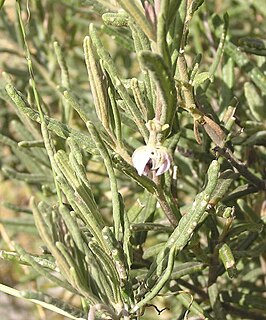
Lasiopetalum oppositifolium is a species of flowering plant in the family Malvaceae and is endemic to the south-west of Western Australia. It is an open, erect shrub with rusty-hairy young stems, linear, narrowly elliptic or narrowly egg-shaped leaves and white, pink and dark red flowers.
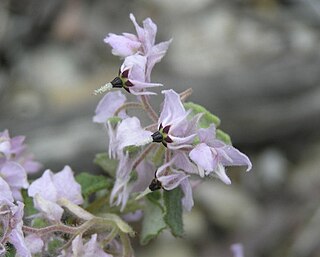
Lasiopetalum rotundifolium is a species of flowering plant in the family Malvaceae and is endemic to the south-west of Western Australia. It is an erect to spreading shrub with hairy young stems, round leaves with a heart-shaped base, and pink and dark red flowers.

Olearia frostii, commonly known as Bogong daisy-bush, is a species of flowering plant in the family Asteraceae and is endemic to Victoria in Australia. It is a low, often straggling shrub with egg-shaped leaves with the narrower end towards the base, and mauve to pink and yellow, daisy-like inflorescences.

Spyridium bifidum, commonly known as forked spyridium, is a species of flowering plant in the family Rhamnaceae and is endemic to South Australia. It is an erect shrub with densely softly-hairy young stems, wedge-shaped to linear leaves sometimes with a two-lobed tip, and densely woolly heads of white-velvety flowers.
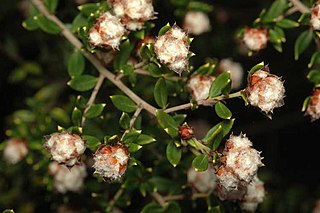
Spyridium buxifolium is a species of flowering plant in the family Rhamnaceae and is endemic to New South Wales. It is a spreading shrub with egg-shaped to elliptic leaves, and heads of white, softly-hairy flowers with brown bracts at the base of the heads.

Spyridium cinereum, commonly known as tiny spiridium, is a species of flowering plant in the family Rhamnaceae and is endemic to south-eastern continental Australia. It is a low-lying shrub with heart-shaped leaves, the narrower end towards the base, and heads of whitish, shaggy-hairy flowers with brown bracts at the base of the heads.



















